This is by far the most popular street food of Kuching, in fact if ever there was a title for the signature dish of Kuching, this humble local pasta wins hands down, though many would also argue that the honour belongs to the other iconic dish: Laksa Sarawak. But there is a reason why the title goes to kolo mee. It’s the statistic. Practically every coffee shop or kopitiam in Kuching has at least one stall for this dish. Some even have more, as there many version of this most popular of Kuching’s street food. So popular is kolo mee among the locals that in fact there is a joke going around that Kuchingites will go nuts if he/she doesn’t have a dish every day! (Ok, I made that up:)
“Kolo mee” in direct translation from its Chinese characters mean “dry, tossed noodle”, the “mee” is the generic term for all noodles, the Chinese version of the west’s pasta. However, Kuching’s kolo mee had over the years formed its definitive and distinctive taste such that a kolo mee connoiseur can easily tell the difference between the kampua mee, a closely similar dish of the Foochow of Sibu, or the wonton mee of West Malaysia with just one chopstick serving.
The manufacture of a good kolo mee’s noodle is a closely guarded secret by many noodle makers, but basically it is flour-and-egg dough churned through noodle making machine into long strips, some thin and straight, some curly, and some are made flat. The ingredients looked simple enough – pork lard, msg, soy sauce, chopped,shallot and fried cut red onion – but in the hands of a master kolo mee maker, the resultant concoction is one of the most sublime dish on this fabled island.
For the preparation, a fistful of noodle is put into a vat with boiling water, when done it is scooped up with a strainer and dunked into a pail of cold water for a few seconds, this purportedly makes the noodle “springy” and not so mushy, then it is transfer into the vat again and immersed in the boiling water for a few seconds before being scooped up and tossed on the bowl with the pork lard, et al. Finally for garnishing, slivers of Chinese barbeque pork is slapped on top as a minimal decoration (some also top it up with minced pork) and voila! Kolo mee ala Kuching!
Kolo mee comes in three shapes, the “curly”, the “straight” and the “flat” or mee pok, they also comes in “white”, which is the regular, “red” which adds red barbeque pork oil for extra fragrance, the “black” with dark soya sauce added. There is also another version with a dash of dark vinegar. But the default version is either the curly or straight “white”, which is what you get if you order “One kolo mee, please”. And if you want the flat mee with red barbeque oil, you say “kolo mee pok, red” and so on. But some stall have the vinegar version as the default.
Two major sub-version of the kolo mee has also evolved and they are the seafood kolo mee and the beef kolo mee. As the names suggests, the former is topped with succulent prawn, fish balls or fish cake in addition to the char siew, while the beef is just another spin of the noodle with beef, beef meatballs and the beef flavour, without the char siew or prawn/fish balls. They usually cost more than the standard fare offered.
Some kolo mee stalls offer an optional pork “spare part” soup, called “cheng”, ie soup with chopped pig intestine, pig liver, pig kidney, cubes of hardened pork blood and flat slices of pork, with salted vegetable as the soup base. This is the perfect compliment to a bowl of kolo (straightmee. Otherwise, just request for a plain bowl of soup, which comes free of charge.
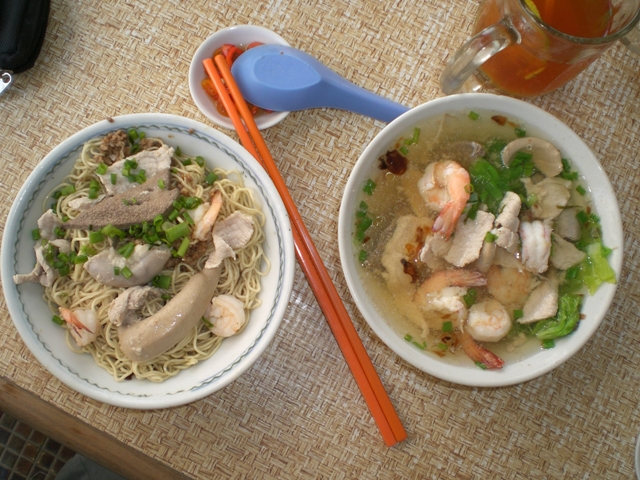
The bowl of soup on the right is the “cheng”, a sinful concoction of pig intestine, kidney, liver in clear soup.
Kolo mee purists in Kuching demands a small saucer of pickled cut chili with a little bit of vinegar which they unceremoniously dump on the noodle before eating. As this version of chili is anything but hot, it can only be concluded that it just psychologically enhances the flavour of the dish in the mind of the eater.
How to differentiate the three version of kolo mee : Most Kuching coffee shops have at least one kolo mee stall. If its signage says “Kolo mee”, it mean it usually has the standard version with the curly, straight and flat, alongside the “white ” and “red” flavour, but without the seafood. But if you see “Seafood kolo mee”, it means this stall usually sells the seafood version only. Whereas, if a stall signage says “beef noodle” or “mee sapi”, it clearly means it’s selling exclusively that, and not standard pork or seafood kolo mee.
It is also interesting to note that local Muslim also have their own halal version of kolo mee. Instead of using pork lard, they use vegetable oil, and either chicken meat or beef, and can be equally tasty and as a testimony of its popularity, this dish has also became a mainstream dish for Muslim at their own halal coffee shops, their signage usually says “mee kolok”.
So now that you know how Kuching kolo mee works, just go out now and holler to the kolo mee stall for a bowl now! Remember, you’ve not been to Kuching if you have not tasted kolo mee!
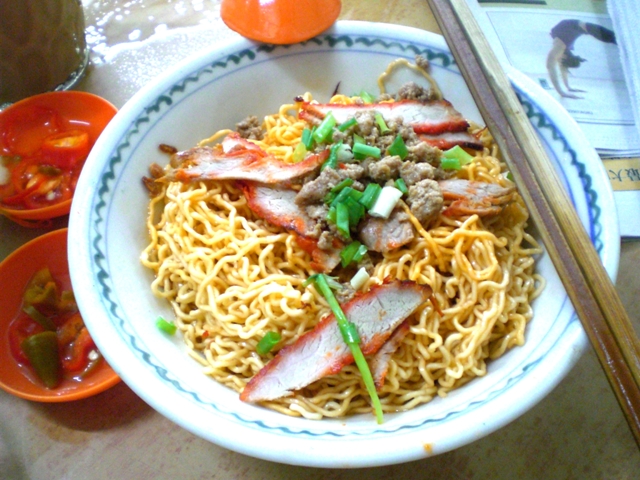
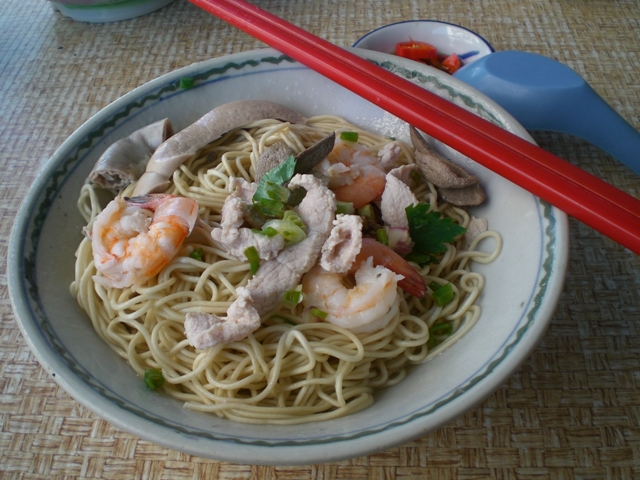
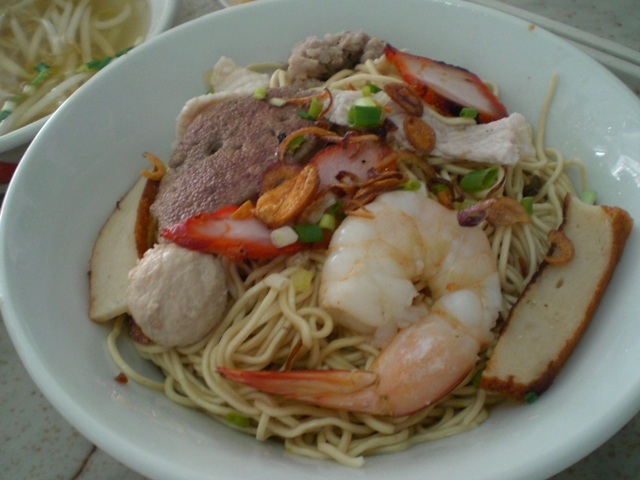
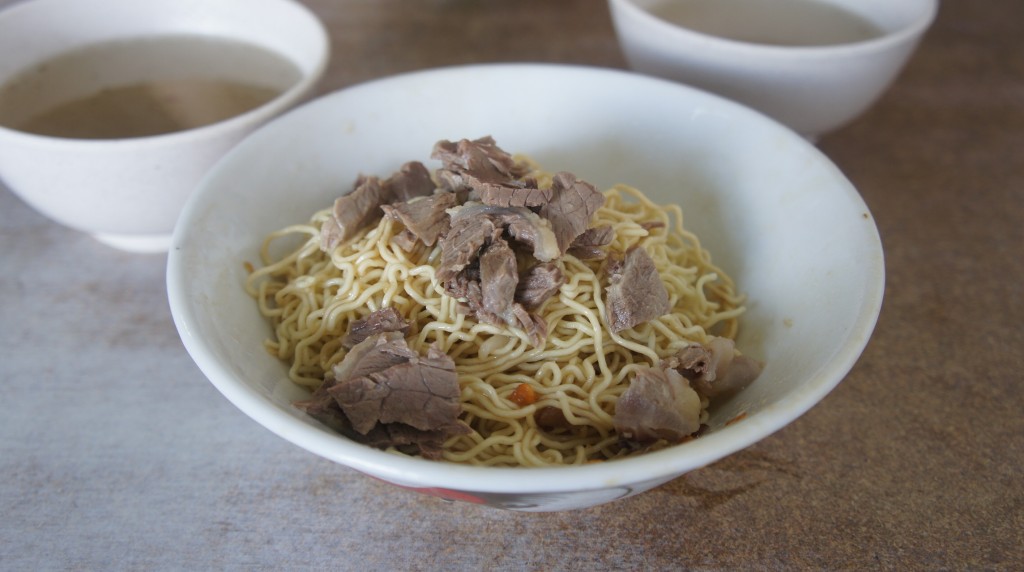














Yummmmm!!! We will always remember our first Kolo Mee! Can’t wait to have some more when we come back to Kuching!